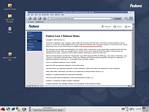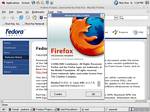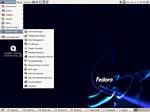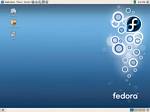The unabated development of Fedora Linux
By Niall C. Brady, November, 2007.If you wish to re-publish this article (or parts of), then you are free to do so as long as it links back to here.
If you enjoyed this article then Please Digg it
Note:- This is the updated version of The evolution of Fedora Core Linux which was published in February 2006.
Introduction
About Fedora
Fedora Core release 1 - Yarrow
Fedora Core release 2 - Tettnang
Fedora Core release 3 - Heidelberg
Fedora Core release 4 - Stentz
Fedora Core release 5 - Bordeaux
Fedora Core release 6 - Zod
Fedora 7 - Moonshine
Fedora 8 - WereWolf
Introduction
I use Linux every day and more often than not, it's Fedora based. The first linux distro I tried was Red Hat 5 and I still remember installing it multiple times in one day in order to gain a better understanding of Red Hat Linux. I stayed with Red Hat Linux right up until the last free version Red Hat 9. It was a superb release but marked the end of such releases from Red Hat and also the beginning of a new, more open, more co-operative (with the community) and more frequently updated operating system called Fedora.When I originally wrote The Evolution Of Fedora Core Linux in 2006, I had yet to try Fedora's biggest competitor, Ubuntu and now, some 21 months later I've not only tried Ubuntu (please see my 30 days with Ubuntu 7.04 article) but I have stayed with Fedora unlike some people who seem unwilling to stay the course.
In this article I hope to cover the continuing development of Fedora over the years and give people a chance to learn a little bit more about it since the first release came to life back in November 2003, how the distro has matured and what to expect from the latest Fedora offering, WereWolf (Fedora 8).
Back to top ^^
About Fedora
We all know that Fedora is a well used and eagerly awaited distro (currently ranked number 4 on distrowatch.com as of November 2007, but what exactly *is* Fedora ?On the Fedora Project website, Fedora is described as:-
The Fedora Project is open and anyone is welcome to join.
The Fedora Project is out front for you, leading the advancement of free, open software and content.
Fedora is a linux distro that is partly sponsored by Red Hat and releases a new major version every 6-8 months or so. In addition, support for the OS is usually also limited to 6-8 months after the release of the next version. Note: This support policy was updated from FCR5 onwards. If you insist on using the earlier releases then do consider upgrading to the latest version either by a fresh install or via yum. There was a project called fedora legacy which added support (security etc) for early Fedora releases (FCR1-FCR4) but it closed down due to lack of interest/demand.
In September, 2003, Red Hat announced the formation of the Fedora Project. Some months earlier however, Fedora Core began life as an operating system in July 2003 when Test 1 (originally called Beta 1) was released. A further two test releases were produced after the first Test release before the first 'final' release of Fedora was made available to the general public on the 5th of November 2003.
That release was code named Yarrow and had the rather exciting title of 'Fedora Core release 1'. I still remember downloading it with enthusiasm, and then installing it on several computers at home. At the time it was released the download mirrors experienced a vast surge of interest as thousands of people wanted to try out the new distro. Many reviews were written, some positive some negative but overall, linux enthusiasts were excited about this new 'Red Hat' distro. Interestingly there was/is an OpenSource 'Fedora' project before RedHat claimed the 'Fedora' name as their own trademark, see here for more info.
The eight major releases of Fedora are listed below:-
Fedora Core release 1 - Yarrow
Fedora Core release 2 - Tettnang
Fedora Core release 3 - Heidelberg
Fedora Core release 4 - Stentz
Fedora Core release 5 - Bordeaux
Fedora Core release 6 - Zod
Fedora 7 - Moonshine
Fedora 8 - Werewolf
There has been much discussion about the code names above, and a quick glance here shows us that Fedora Core releases from 1 to 5 were codenamed after alcohol in one way or another (beer+wine) and then FCR6, F7 and F8 subsequently relate to a character in DC Comics universe, a record label and a movie.
The move away from alcohol related codenames would lead one to believe they sobered up when thinking of them ;-). Still, whatever the reason, I prefer Fedora's codenames' by far, compared to another very prominent distro (hint hint).
Fedora's subsequent release into the world of linux distros was quickly followed by 'fedora' site's such as the excellent fedora faq, fedora forum and fedora news all aiming their content at the thousands of loyal Fedora users.
Take a look at the selection of screenshots below, you can see the 'look' of each of the Fedora releases so far. Click on the thumbnails for a full sized high-resolution PNG screenshot.








Back to top ^^
Fedora Core release 1
YarrowYarrow was the first release of Fedora (release notes here). It was based on the 2.4 kernel (the last Red Hat distro to do so), came on 3 cd's (or 6 if you include the SRPMS), had gnome-desktop-2.4.0-1 (Red Hat likes to stick with Gnome as the default desktop), and had most of the latest and greatest packages strapped on at the time. Even though Fedora clearly stated their 'about' section that Fedora can't play MP3 files it was one of the things that users complained about when it was released. In addition to lack of MP3 support they wanted help with Java, Flash, Mplayer, Xine. Yeah, the usual stuff. In the end though, there were 3rd party patches or rpm's available to do the things that were not included by default in the distro. This has remained the same since FCR1 hit the binary shelves and as Red Hat say
Fedora Core release 1 introduced a graphical boot, (rhgb or redhat graphical boot) which gives the user a cleaner interface when booting the system (less info, more graphics). This feature also included the ability to 'show details' so you could actually see if eth0 got an ip or not. Fedora Core release 1 also included NPTL (native posix thread library) which was supposed to provide performance improvemants and increased scalability via the 2.4.22-1.2115.nptl kernel.
FCR1 for me was fantastic, I used it right up until FCR2 was released, then switched immediatly to see what the new release was like. However, that said, I kept an old laptop running under my stairs serving this website and others for 497 days or so until the kernel uptime counter reset and that 'inspired' me to move to a newer kernel (and in the process a total update from FCR1 to FCR4).
So in a nutshell, FCR1 was stable for me, did everything I wanted it to do except certain power management features, which were to come later as the linux kernel itself (2.6 series) added more features for modern chipsets in notebooks.
It was a major release and well reported upon (some samples below).
Flexbeta review
OSnews review #1 review #2
LinuxElectrons review
Back to top ^^
Fedora Core release 2
TettnangWithin 6 months of the first release of Fedora came the second installment called Tettnang (release notes here) and it was available on 4 cd's (up one from the last release). As soon as it hit the mirrors I downloaded and installed it. This was the First release of Fedora with the 2.6 kernel and that in itself justified the download, however it wasn't plain sailing for everyone and some dual-boot users had problems with the installation rendering their Windows installation unbootable or worse. However, this was not specific to Fedora and impacted quite a few distros released at that time that were based on the linux 2.6 kernel (Mandrake 10, Suse 9.1 and Fedora 2).
In addition to these dual-boot woes, were other issues that had people screaming such as
Nvidia drivers failing to load
Nautilus Spatial mode
Selinux causing unusual problems
All of the above were quickly referenced and fixed with new releases and/or workarounds. For example, the reason nVidia drivers wouldn't work with the default kernel on FCR2 was because the developers enabled the 4KSTACK option in the 2.6.x kernel and that was incompatible with the 8KSTACK nVidia drivers. Subsequent drivers from nVidia and/or kernel recompile resolved the issue. Spatial mode in Gnome's nautilus was also very easy to fix but generated a lot of articles none-the-less.
Fedora Core release 2 was noticeable because it replaced XFree86 with Xorg and in addition it introduced an implementation of Selinux to the masses (installed by default but disabled). It's also worth mentioning that this release of Fedora continued in the move away from Red Hat being ever present in the OS by renaming all those 'redhat-config-xxx' commands to 'system-config-xxx'. However, the Red Hat logo was still clearly visible in the Gnome menu.
I still have my Fedora Core release 2 installation, and when needed, I plug the harddisc back into a laptop to demonstrate PXE booting disc-less computers to the FCR2 box which has a PXE server, DHCP server, iptables configured for NAT and Thin Client functionality for the machines connected to it. Very impressive stuff indeed (I demo'd PXE booting a disc-less box to the FCR2 laptop which in turn had a wireless connection to the network, and using iptables to share that internet connection I used tsclient (rdesktop) to connect to a Windows box in a different country. The attendees were very impressed).
Back to top ^^
Fedora Core release 3
HeidelbergHeidelberg (release notes)was released in November 2004 and by now the Fedora 'ship' was well and truly on the move. Interest in Fedora continued to climb as each new release was published and by now, Fedora was a real distro to contend with (10 reviews of FCR3 listed on distrowatch.com compared to 5 for FCR1).
Fedora Core release 3 brought Gnome 2.8 to the Fedora masses (and that was an excellent update to the default desktop) and now also came with the improved 2.6.9 kernel. Speaking of the kernel, Heidelberg introduced another change to the old way of doing things, now when you upgraded your kernel, the new kernel would be listed as the default in your boot configuration.
As a side note, Fedora users now had Firefox installed as the default web browser (previously it was Mozilla). While adding Firefox as the default web browser might seem a small thing, it was actions like this that helped to make Fedora such a big hit with it's users. Mozilla was still there, just not the default anymore.
Visually, the Fedora desktop (via Gnome) changed and now there were two panels, one above and one below as you can see here. When I first tried this new Gnome layout I found it a little weird, but soon (very soon) got used to it and now I feel right at home with the menu system being at the top of my desktop.
The third release of Fedora consolidated things learned from the first two releases, applications feel more mature (and they are) the desktop looks sleek and professional, the system is more stable than Fedora Core release 2 was and Selinux now works. Of course there were minor issues like Eggcups has unexpectedly quit and users discovering that Fedora releases do also tend to carry some bugs.
However, these very same bugs in the final releases are usually resolved via a yum update. Case in point when FCR3 was released to mirrors there were already updates available for it on 'up2date'. Some user's just don't understand this and end up criticising this fine distro instead of embracing it's values and realising that each release is still a 'work-in-progress' and as such, never really 'finished'.
Heidelberg for me was a great if understated release, it definitely felt more mature than Tettnang (thanks in large part to Gnome's advances) and my partner found that even she could use linux when I installed FCR3 on her laptop for her (dual boot with XP). She continued with FCR3 until we bought a new digital camera (Canon EOS 350d) which FCR3 didn't recognise, and at that point I installed FCR4 for her (which recognised the camera just fine).
Back to top ^^
Fedora Core release 4
StentzThe fourth major release of Fedora (Stentz) was released in June 2005 (release notes) and had now bumped its review status on distrowatch to 13 from the previous 10 for FCR3. Stentz holds the status of being the first linux distro to be compiled using GCC4 which was released in April 2005, GCC 4.0 compiled faster than GCC 3.4.x and not only that, it produced smaller binaries. The end result, faster machine. That's all well and good, but did it make Fedora Core release 4 better ? Yes and no. Yes because there were speed improvements (boot time etc) and no because so many packages now needed to be re-compiled.
If you take a look at this short video of FCR4, you'll get a good idea of the installer in action and the OS itself.
I did have some issues with installing Stentz, and these issues were always related to hard disc partitioning (particularly if you had more than one hdd in the computer) and Fedora's use of LVM. The bug appeared to be related to SATA capable computers and was documented here and here.
This bug was very annoying and occurred on at least 3 separate laptops that I attempted to install Stentz on. In the end, the only way I could get FCR4 to install without a kernel panic on first boot was to manually choose the filesystem type during setup. Changing it from the default of LVM to ext3 worked perfectly on all systems I had.
Once this bug had been overcome using Stentz was indeed a pleasure, at least until an update killed xorg. That bug too, was quickly resolved and soon I was using Stentz with full MP3, dvd and NTFS capabilities.
Stentz certaintly had some issues but they have since been resolved and are well documented. Is it stable ? definitely. This site (linux-noob.com) ran exclusively on Fedora Core release 4 for over a year with little or no problems (currently running FCR6 as of November 2007).
Stentz was a very solid and capable OS (both for desktop use and server use) once you tweaked it to your satisfaction and got around the annoying bugs (which seemed to be related to newer hardware with Intel chipsets).
Back to top ^^
Fedora Core release 5
BordeauxBordeaux was officially released March 20, 2006 (release notes). It sported a bubbly new theme and the first use of the new Fedora logo (replacing the Red Hat in Gnome's menu). Packaging in FCR5 has been redesigned with the help of two new applications, Pup and Pirut, Pup checks both Fedora's and other repositories that you may have signed up with for updates and informs you when they are available, Pirut on the other hand allows you to search a list of available or installed packages.
The FCR5 desktop had early work from the Fedora Rendering Project integrated into the Desktop (AIGLX), this supported lots of effects such as menu fades and minimization. The new login screen in Fedora Core release 5 was really nice, and visably shook if you entered your password incorrectly.
Fedora Core release 5 now included Hal and Gnome Support for Hard Disk Encryption (Luks) and Gnome itself was updated to the 2.14 release and looked more streamlined and professional than previous releases. FCR5 also included Mono support for the first time, and Mono applications such as Beagle (a desktop search interface), F-Spot (a photo management utility) and Tomboy (a note-taking application).
The installation procedure in FCR5 was similar to previous releases but noticably moved away from the 'everything, minimal, desktop' type of installation choices in previous Fedora releases. Now the user was given the choice to install FCR5 with support for 'Office and Productivity', 'Software Development' and/or 'Web server' (see screenshot). Of course you could click on the 'Customize now' button and change your preferences (for example, install KDE instead of Gnome).
The default kernel (2.6.15-1.2054_FC5) provided with FCR5 didn't like non-GPL modules and as a result nVidia and ATI drivers wouldn't install properly, in addition some Intel 9xx graphics chipsets didn't display the correct resolution on their LCD's. All of these issues were fixed very quickly however by the community either via patches or updated kernel/drivers. Fedora Core release 5 now had extended life support (or rather, update support), and this welcome change was brought about by The Fedora Board in conjunction with Red Hat Engineering. This meant that FCR5 had a lifespan of 15 months compared to the previous 11 months if under the old policy.
Back to top ^^
Fedora Core release 6
ZodFedora Core release 6 (Zod) was officially released October 24th, 2006 (release notes). Zod included support for Compiz/AIGLX, new versions of GNOME (2.16) and KDE (3.5.4), a beautiful new theme (DNA), multiple performance improvements, and much more (even bzflag was back after taking a vacation in Fedora Extras in FCR4).
Zod was probably the first version of Fedora that really had that gee-whizz feel to it, you could have groovy desktop effects with Compiz/AIGLX (the packages were installed by default and could be accessed from System > Preferences > Desktop Effects, provided that your video card had 3D support enabled) and you could easily install Beryl to impress your friends. Sure Fedora Core release 5 had experimental AIGLX, but that was via an optional experimental repository.
Fedora Core release 6 included IPV6 support during the installation, plus the installer now had the ability to add custom repositorys to pull packages from. The overall notification framework had been improved so when new updates were available you were notified with a very nice looking notification message in the system tray (top right of screen). The desktop update notifications were now handled by Puplet (yum-updatesd) which replaced both the up2date and rhn-applet packages from Fedora Core release 5.
SELinux (which first shipped in Fedora Core release 2) was now improved even further with the release of Zod, with a targetted policy turned on by default and a SELinux troubleshooting tool. The tool would show itself in the desktop notification area by notifying you when security access denials occur and in addition it would inform you about which portion of SELinux's policy you need to be looking at in order to resolve the issue.
Distrowatch reported 16 reviews of Zod (compare that to 3 reviews for FCR1), so it was easy to see the growing popularity of Fedora. Speaking of popularity, Fedora Core release 6 had 2 million installs registered within 4.5 months after it was released. That impressive figure was gathered when the Fedora team decided to track the number of users with unique IP addresses who connected to yum in search of updates for a new installation of FCR6.
Fedora Core release 6 was the last in a line however, and the 'Core' part of the distro name that we were all accustomed to, was to be dropped. Fedora Core was no more, Fedora Core was to be called just plain old Fedora. Why ? Red Hat themselves wrote:-
Back to top ^^
Fedora 7
MoonshineMoonshine was officially released May 31st, 2007 (release notes).
Perhaps the biggest point to note about Fedora 7, was the fact that 'core' and 'extras' were now bundled together in the release (see Nottingham's quote above for FCR6), and indeed Max Spevack (Chairman, Fedora Project) said:-
"A big goal for Fedora 7 was the merge of Core and Extras and the result was anyone being able to generate their own custom version of Fedora as easily as possible. What we've got there are some tools. The basic ones that were built include "Pungi", which is the distribution compose tool. It takes a pile of RPMs and turns them into an installation tree. And there's also "livecd-creator", whose name makes it pretty obvious what it does."
The revisor tool combined livecd-creator (command line tool) and Pungi to give a wizard-like program for building both installable ISOs and live ISOs. Spevack also said that adding the live cd/live DVD stuff was something Fedora 'needed in order to be able to compete'.
Moonshine added spins to this release, each one catering for a different audience, Gnome and KDE specific Live-CDs and Live-DVDs for x86 and x86-64 platforms. In addition, an extras DVD was made available with everything included suitable for distribution to those without broadband access. The inside work on the infrastructure side of Fedora 7 (Koji build system, Bodhi update system and a new more efficient mirror manager) was a big part of the effort that went into getting Moonshine released.
For those of us not interested in creating our own Fedora Distro, we were happy to see that Moonshine shipped with an updated kernel (2.6.21-1.3194.fc7), Gaim was renamed to Pidgin and finally Firefox was updated to version 2, this was important as FCR6 shipped with Firefox 1.5 which was out of date the day FCR5 was released. Once again the artwork changed and a hot air balloon graced the Fedora 7 desktop (and artwork).
The decision by the Fedora project team to start measuring statistics in Zod now expanded even further with the release of Moonshine. During the firstboot phase (just after installation) one of the questions you are asked is if you wish to send your hardware profile to the Smolt Project. Taking this optional (but recommended step) is a great way of providing data which can be used to compile an ever evolving hardware compatability list for Fedora. This list is being enhanced to provide a wiki and a rating system with detailed hardware compatibility information as you can see in this example. If you have installed Moonshine and missed this step for whatever reason, open up a terminal and type smoltSendProfile. The desired effect of all these statistics is better software through better metrics.
Back to top ^^
Fedora 8
WerewolfWerewolf was officially released November 8th, 2007 (release notes).
There are so many new features in Fedora 8 that it would warrant a separate review (coming soon), however I will try and cover some of the main points here.
Custom spins are variations of Fedora built from a specific set of software packages and in Werewolf, there are three new Custom spins shipping namely: Games, Developer and Electronic Lab. These custom spins allow the user to boot a system with a live DVD and do that tasks associated with the spin, for example, test out gaming without changing what is installed on the computer. In addition, Fedora is available on 'live-cds' one Gnome based version, and one KDE, these are useful to see if your hardware will work with Fedora, and if it does, you can click on the 'Install to Hard Drive' icon to start the installation.
Next up, we have PulseAudio, and anyone familiar with Windows Vista's audio capabilities will understand what PulseAudio is about (per application audio control). Fedora 8 is the first distro to have this enabled by default. This one feature alone in WereWolf could be described as the 'killer app'.
Codec Buddy has finally appeared in Fedora and about time too, every single release of Fedora up until this point was encumbered with having to do post-installation setup of multimedia codecs, etc due to legal issues. Codec Buddy is a wrapper for gstreamer applications which can launch a wizard to prompt the end user to download an MP3 codec (free) for example, or audio/video codec for watching DVD's (with a price tag). I tested this ability in Fedora 8 by launching Totem and trying to play an MP3, this in turn brought up the CodecBuddy and after accepting the license agreement I was listening to the MP3. When I later tried to play back an MPG file in Totem I was once again prompted to install a codec for audio/video, but this one had a small pricetag (10 Euros or so). So the functionality is there and for the first release of Fedora to have CodecBuddy, I think we'll be seeing a lot more of this in the future, well done Fedora Devs.
Fedora 8 also brings a new graphical firewall configuration tool called system-config-firewall, this tool allows users to quickly and easily configure their firewall. Werewolf also claims to have better laptop support, which is always popular, and I for one can only agree, my wireless nic (0c:00.0 Network controller: Intel Corporation PRO/Wireless 4965 AG or AGN Network Connection (rev 61)) worked out of the box, all I had to do was configure WEP.
Hardly a release goes by without some new artwork or 'look' and Fedora 8 is no exception, the new look (default theme) is called 'Nodoka' and the new desktop artwork 'infinity' which has a rather cool new wallpaper, depending on the time of the day it can vary from bright blue (mid-day) to a warm orange hue at sun-set. Compiz is installed by default in both Gnome and KDE, however it's not enabled by default, the Fedora developers hope that it's mature enough for the next release of Fedora to be enabled by default. Compiz-Fusion can be installed via Add/Remove software or yum.
Another new feature is the Online Desktop, to install it you have to click on Add/remove software and type in the name of the package (online-desktop). Once installed, restart X (ctrl_alt_backspace) and choose session at the login screen, you can choose the online-desktop demo and you'll get to see what it is about. You'll have a sidebar on the left of the desktop, and your applications system tray is now gone from the top of the screen, to launch apps you can click on them from within your sidebar. If you want to customise it then create an account at Gnome online (http://online.gnome.org), fill in the info you want and acknowledge the welcome mail. This particular feature is supposed to adapt your desktop to bring together applications like GMail, Photobucket, Facebook, EBay, Wikipedia and others. Pirut (the package manager) has also been updated and now allows you to easily add, remove and enable or disable repositories, and of course, it is all faster in this release.
Well by now you are hopefully either downloading Werewolf or using it. The dust has hardly settled on the release of WereWolf and even so, Fedora's development is continuing with tremenduos force, the plans, seeds and ideas for Fedora 9 are already being put in place.
I'm quite sure that Fedoras' competitors must wonder what tricks are left up Fedoras' seemingly endless sleeves, and my guess is 'many'.
Back to top ^^
(c) linux-noob.com 2007.
please send corrections/suggestions to anyweb@linux-noob.com
Thanks go to Rahul Sundaram for assistance with the Zod, Moonshine and WereWolf sections,
plus (more importantly) for motivating me to write this.
This article was written in Fedora 8 using vi, ssh and Gimp.
If you enjoyed this article then Please Digg it